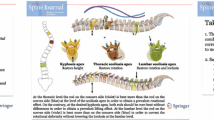Abstract
Purpose
In our article, we would like to introduce a new auxiliary implant called the CAB hook, for use in posterior approach scoliosis surgery.
Methods
Since 2007, we operated 42 patients with the CAB hook with an average preoperative Cobb angle of 59.3° (28°–92°). In three cases, the posterior approach was preceded by ventral release and Halo traction. In four cases, besides the CAB hooks, SCS hooks and pedicular screws, in three cases both CAB and SCS hooks, in nine cases CAB hooks with SCS pedicular screws, and in 23 cases, only CAB were used. The average follow-up time was 21.6 month (2–51).
Results
All the patients are satisfied with the results. No reoperation was needed due to the loss of correction, pain, implant failure, or infection. The average postoperative Cobb angle decreased to 24.7° (4°–60°). Based on this we calculated the Cincinnati Correction Index (CCI), which was 1.53 (0.7–4.8), which means that our correction exceeded the flexibility of the spine based on the lateral bending X-ray by 53 %.
Conclusion
As with all new surgical techniques and implants after the short learning curve, we were able to improve the degree of correction and decrease the time of surgery. One of the advantages of the CAB hook is that besides a few implant-specific instruments, no special instrumentation is required for insertion, and image intensifier need not be used.



Similar content being viewed by others
References
Abul-Kasim K, Ohlin A (2011) The rate of screw misplacement in segmental pedicle screw fixation in adolescent idiopathic scoliosis. Acta Orthop 82(1):50–55
Amiot LP, Lang K, Putzier M, Zippel H, Labelle H (2000) Comparative results between conventional and computer-assisted pedicle screw installation in the thoracic, lumbar, and sacral spine. Spine 25(5):606–614
Balabaud L, Gallard E, Skalli W, Dupas B, Roger R, Lavaste F et al (2003) Biomechanical evaluation of a bipedicular spinal fixation device: three different strenght tests. Eur Spine J 12:480–486
Bauer R, Kerschbaumer F, Poisel S (1993) Atlas of spinal operations, 1st edn. Georg Thieme Verlag, Stuttgart
Cotrel Y, Dubousset J (1984) A new technic for segmental spinal osteosynthesis using the posterior approach. Rev Chir Orthop Reparatrice Appar Mot 70(6):489–494
Cotrel Y, Dubousset J, Guillaumat M (1988) New universal instrumentation in spinal surgery. Clin Orthop Relat Res 227:10–23
Csernátony Z, Szepesi K, Gáspár L, Dezső Z, Jónás Z (2000) “The rotational preconstraint”. A kinetic model of a possible new mechanism in the ethiopathogenesis of scoliosis. Med Hypotheses 54(2):203–206
Csernátony Z, Goodship A, Szepesi K, Jónás Z, Gáspár L, Benkő K et al (2001) A complementary thoracic implant for the surgical correction of the scoliotic curve. A preliminary report. Eur J Orthop Traumatol 11:85–89
Csernátony Z, Szepesi K, Gáspár L, Kiss L (2002) Contradictions of derotation in scoliosis surgery using the CD principle. Med Hypotheses 58(6):498–502
Csernátony Z, Molnar S, Zs Hunya, Manó S, Kiss L (2011) Biomechanical examination of the thoracic spine—the axial rotation moment and vertical loading capacity of the transverse process. J Orthop Res 29(12):1904–1909
Harrington PR (1962) Treatment of scoliosis. Correction and internal fixation by spine instrumentation. J Bone Joint Surg Am 44:591–610
Karger C, Steib JP, Roussouly P, Chopin D, Roy C, Dimnet J et al (1995) Les ‘nouveaux’ systèmes d’ instrumentation rachidienne postérieure. Expansion Scientifique Française Cahiers d’ Enseignements de la SOFCOT. Paris, pp 121–35
King HA, Moe JH, Bradford DS et al (1983) The selection of fusion levels in thoracic idiopathic scoliosis. J Bone Joint Surg Am 65:1302–1313
La Rosa G, Giglio G, Oggiano L (2011) Surgical treatment of neurological scoliosis using hybrid construct (lumbar transpedicular screws plus thoracis sublaminar acrylic loops). Eur Spine J 20:90–94 (Suppl. 1)
Luque ER (1989) Segmental spinal instrumentation in neuromuscular scoliosis. Orthopade 18:128–133
Mazda K, Ilharreborde B, Even J, Lefevre Y, Fitoussi F, Pennecot GF (2009) Efficacy and safety of posteromedial translation for correction of thoracic curves in adolescent idiopathic scoliosis using a new connection to the spine: the Universal Clamp. Eur Spine J 18:158–169
Ovadia D, Korn A, Fishkin M, Steinberg DM, Wientroub S, Ofiram E (2011) The contribution of an electronic conductivity device to the safety of pedicle screw insertion in scoliosis surgery. Spine 36(20):1314–1321
Sanders J (2011) Scoliosis “nonfusion”—a reality check. J Pediatr Orthop 31(1 Suppl):114–118
Vora VCA, Babekhir N, Boachie-Adjei O, Lenke L, Peskin M, Charles G, Kim Y (2007) A pedicle screw construct gives an enhanced posterior correction of adolescent idiopathic scoliosis when compared with other constructs: myth or reality. Spine 32(17):1869–1874
Acknowledgments
No funds were received in support of this study.
Conflict of interest
None.
Author information
Authors and Affiliations
Corresponding author
Rights and permissions
About this article
Cite this article
Csernátony, Z., Kiss, L., Manó, S. et al. Our experience and early results with a complementary implant for the correction of major thoracic curves. Eur Spine J 22, 1286–1291 (2013). https://doi.org/10.1007/s00586-013-2698-4
Received:
Revised:
Accepted:
Published:
Issue Date:
DOI: https://doi.org/10.1007/s00586-013-2698-4




